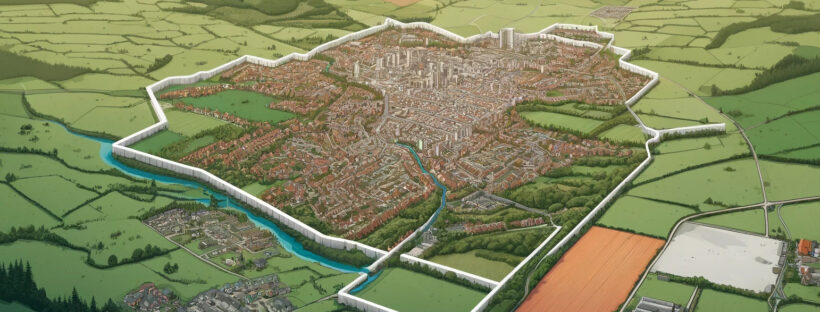Between 2011 and 2021, Four Marks & Medstead ward has experienced an unprecedented 40% increase in population1. Despite this rapid growth, not a single full Environmental Impact Assessment (EIA) has been conducted for any of the developments during this period. The combined impact of recent developments in the Four Marks & Medstead ward has been significant. Thus, EHDC failed our ward in terms of their duty to ensure that they only permit development that adheres to sustainable development principles.
Applying a one-size-fits-all approach is a procedural fallacy, particularly concerning the threshold for triggering a full Environmental Impact Assessment (EIA). This threshold should be relative to the type of settlement, varying between villages and towns. Essentially, the criteria for defining a “large development” and/or “significance” should take into account the scale and impact relative to the specific characteristics of the settlement.
This could be measured in terms of the percentage increase in dwellings or population, adjusted to reflect the smaller scale and greater sensitivity of villages compared to larger towns or urban areas. A relatively modest increase in dwellings or population in a village can significantly affect its character, infrastructure, and environment. Thus, a development considered small in a larger town may be deemed large-scale in a village context, warranting a more thorough EIA process.
The Town and Country Planning (Environmental Impact Assessment) Regulations 2017, which transpose the EIA Directive into UK law, require that the EIA process considers the “indirect” and “cumulative” effects of a project. This encompasses the combined impact of the project with other existing, approved, and delivered developments in the area. Therefore, when evaluating the environmental impact of a proposed development, it’s essential to assess not only its individual effects but also how it interacts with other past, present, and future developments in the area.
The process currently lacks effectiveness in ensuring the full impartiality of experts’ opinions considered during the Environmental Impact Assessment (EIA) screening application. As long as these experts are hired by the applicant or developer, there is a risk of selective use of data (choosing data or studies that support the developer’s position while disregarding contradictory evidence), underreporting of findings (minimising or omitting findings that could raise concerns about the proposed development’s impact), and framing of recommendations (proposing mitigation measures that are insufficient or unlikely to be effective).
Therefore, it is an absolute must that before permitting any further development, even relatively small estates, in the Four Marks & Medstead ward, EHDC should:
1. Conduct a post-development environmental and social assessment to identify and address any unmitigated impacts. This will ensure that any negative effects on the environment and community well-being are recognised and remedied appropriately.
2. Effectively engage with the local community to understand their concerns and involve them in decision-making processes for future developments. This inclusive approach helps to ensure that development plans align with the community’s needs and values.
3. Implement corrective measures and mitigation strategies as needed. Based on the findings from the post-development assessment, take necessary actions to mitigate adverse impacts and enhance positive outcomes for the community and environment.
4. Review the EHDC processes to prevent uncontrolled expansion without full EIA, even if the developments are of a piecemeal nature. Ensure that these smaller developments are considered significant due to their combined impact on the community and environment.
5. Ensure complete impartiality of experts providing opinions for EIA screening applications. Review and improve the EHDC processes to guarantee that expert assessments are unbiased and based on rigorous, transparent criteria, thereby maintaining public trust and credibility in the decision-making process.
These steps aim to create a more sustainable, transparent, and community-focused approach to development in the Four Marks & Medstead ward.
The absence of a full Environmental Impact Assessment (EIA) has wronged our community’s interests in the following ways:
1. Unidentified Impacts: Without an EIA, the potential environmental impacts of the development might not have been properly identified or mitigated. This includes impacts on local ecosystems, water resources, air quality, and biodiversity.
2. Uncontrolled Pollution: There could be increased pollution (air, water, noise) that has not been addressed or controlled adequately.
3. Unplanned Growth: The infrastructure may not have been upgraded to handle the increased population, leading to overburdened roads, water supply systems, sewage treatment, and public transport.
4. Service Overload: Public services like healthcare, education, and emergency services may be strained, affecting their quality and availability.
5. Missed Opportunities for Mitigation: An EIA would have identified measures to mitigate negative impacts, which are now potentially unaddressed.
6. Long-term Effects: Without an EIA, the long-term sustainability of the development is questionable. Environmental degradation and resource depletion could have lasting negative effects on the village.
7. Resilience: The village may be less resilient to future challenges such as climate change, resource scarcity, and further population growth.
8. Disruption: Existing residents may have experienced significant disruption without adequate measures to mitigate these effects.
9. Cultural Impact: The rapid increase in population could have altered the social fabric and culture of the village, potentially causing friction or loss of community identity.
References









